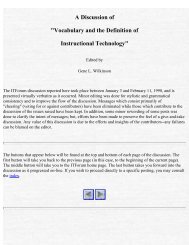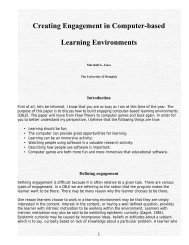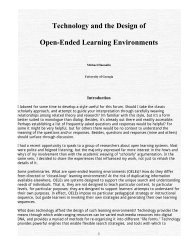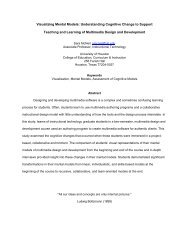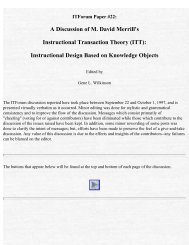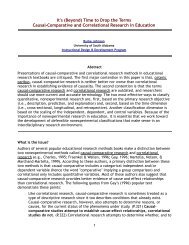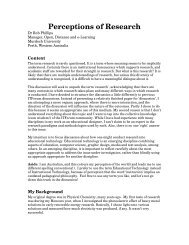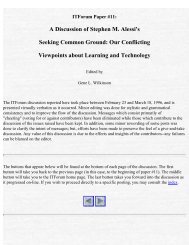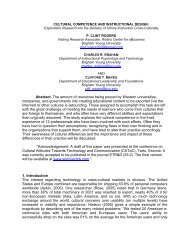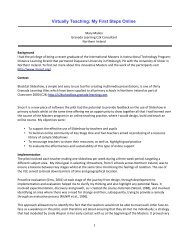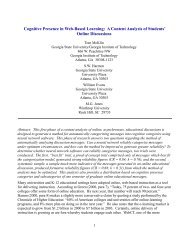SMART EDUCATION: BLENDING SUBJECT EXPERTISE WITH THE CONCEPT OF ...
SMART EDUCATION: BLENDING SUBJECT EXPERTISE WITH THE CONCEPT OF ...
SMART EDUCATION: BLENDING SUBJECT EXPERTISE WITH THE CONCEPT OF ...
Create successful ePaper yourself
Turn your PDF publications into a flip-book with our unique Google optimized e-Paper software.
Even as I examine these models, explore how CD would facilitate contextual learning, and<br />
understand relationships between various types of thinking vital for self-organized learning, a<br />
four component model proposed by Naparstek (2002) to understand children’s learning<br />
problems lends additional support to my thesis. It also blends well with Reigeluth’s (1999)<br />
continuum mentioned earlier. Extending Klatzky’s (1980) component model for memory to<br />
learning in schools, and his research on information processing and prosocial behavior,<br />
Naparstek argues that students must be successful in four interconnected components: paying<br />
attention, ability, effort and organization to realize their fullest academic potential. In my<br />
view, current efforts to raise achievement standards of students seem to focus on just two<br />
factors listed under “ability:” intelligence and academic skills, identified by Naparstek (2002,<br />
p. 4) in his model. The other 20 factors listed under the other three components are equally<br />
important. The importance of some of these factors: interest, poor curriculum match, selfesteem,<br />
confidence, relevance, persistence, work habits, routine and planning listed by<br />
Naparstek have been mentioned in this manuscript. The rationale for CD proposed in this<br />
study addresses these very factors.<br />
Low Stress and High Challenge<br />
How do individuals learn? To illustrate a personal example would be relevant here. I will<br />
narrate now my reflections on how I learned to play table tennis (TT) when I was 13. For<br />
several months, as a teenager, I observed periodically how experts in a local club played the<br />
game. I consciously resisted taking a swing at the ball for almost three months. After<br />
internalizing the various processes observed, I finally “decided” to hit the ball “flat” and<br />
generated incredible force. I never attended a coaching camp (unfortunately?), to help me<br />
develop a conventional “top spin” style, but created this indigenous style to play competitively<br />
against my opponents. Simon (2001, p. 207) observes “at least 90% of what we have in our<br />
heads is acquired by social processes, including watching others, listening to them, and<br />
reading their writings.” The example of learning to play TT illustrates that even physical<br />
abilities could be learned by observation. Further, participating in several tournaments, I<br />
learned how winning often starts with a mental conception. A common joke about golf being<br />
95% mental and 5% physical (or in the mind) illustrates this too. In professional counseling,<br />
the term used for this process is called intentionality. According to Hockaday, Purkey, &<br />
Davis (2001) “it is the ability of individuals to link their inner consciousness and perceptions<br />
with their purposes and actions” (p. 219). Their study found that “the clearer and more<br />
specific the mental process is, the more likely it is to be acted on (ibid, p. 224).”<br />
Along with helping students develop positive perceptions about learning in the classroom,<br />
how can teachers practically address CD issues? While discussing these concerns with<br />
Professor Rich Feller at Colorado State University, he mentioned a Canadian model called<br />
BLUEPRINT, accessible online at http://www.blueprint4life.ca Built on research over a<br />
decade and modifying the CD competency framework in the NCDG, this model not only maps<br />
career development competencies for students and adults, but also complements these with<br />
performance indicators to elaborate on these competencies. These aspects tie the<br />
BLUEPRINT model neatly with my passion for CBPE too.<br />
Professor Feller also introduced me to The Real Game Series (http://www.realgame.com)<br />
that “incorporates interactive learning strategies that enhance and accelerate the acquisition<br />
of knowledge and skills. The game format brings fun, stimulation and excitement to career<br />
15



